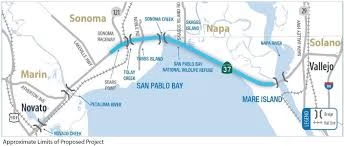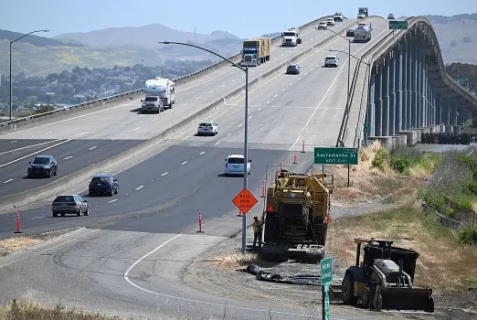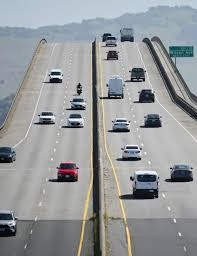California Governor Gavin Newsom signed Assembly Bill 697 into law on October 8, 2025. The bill, authored by Assemblymember Lori D. Wilson, is intended to expedite improvements to Highway 37 in the North Bay region.
Supporters say AB 697 will remove legal delays and unlock billions for road, ecological, and flood resilience work. Critics caution about local control, environmental trade-offs, and community impacts.
The Highway 37 improvement project is a multi-phase initiative aimed at reducing chronic traffic congestion and addressing recurrent flooding issues along the vital 21-mile corridor connecting Solano, Napa, Sonoma, and Marin counties in California. The project is designed to be resilient to projected sea-level rise through 2050.
Key aspects of the project include:
Road Widening: The near-term “interim” project, valued at around $500 million, will widen a 10-mile stretch between Sears Point and Mare Island from one lane in each direction to two lanes in each direction.
New Lanes and Tolls: The added lanes will include a free high-occupancy vehicle (HOV) lane for carpools and a new tolled lane in each direction.
Infrastructure Upgrades: The initial phases involve operational improvements at the SR 37/SR 121 intersection, replacement of the Tolay Creek Bridge, and extending the eastbound merge lane.
Environmental Restoration: A major component includes the restoration of some 1,200 acres of historic San Pablo Baylands, providing nature-based flood resilience and enhancing habitats for protected species like the salt marsh harvest mouse and California Ridgway’s rail. AB 697 streamlines the environmental review process for this work.
Future Planning: The near-term project serves as a “fix” while long-term plans (referred to as the “ultimate project”) are formalized. The long-term vision includes elevating the entire 21-mile highway, potentially on a causeway, to adapt to long-term sea-level rise beyond 2050.
Why Highway 37 Matters
Highway 37 is a critical east-west route north of San Francisco Bay. It links Marin, Sonoma, and Solano counties. Currently, it suffers from congestion, flood risks, and limited capacity.
The road corridor runs through sensitive marshlands and tidal zones. It is vulnerable to sea level rise and storm surge. Upgrading it involves both transportation and ecological considerations.
The move to streamline these improvements mirrors broader infrastructure initiatives nationwide, such as Virginia’s recently announced $4 billion investment in Interstate 81 upgrades. Under AB 697, the California Transportation Commission and other agencies gain new authority to accelerate planning and regulatory review. This aims to speed environmental permits, right-of-way acquisitions, and infrastructure design.

Project Factsheet: AB 697 – Highway 37 Improvements
Bill / Legislation AB 697 (signed by Governor Newsom)
Purpose Streamline processes for Highway 37 improvements across multiple counties
Primary Agencies Caltrans, California Transportation Commission, regional agencies
Scope Road widening, flood resilience, ecological restoration, design & construction
Geographic Extent Corridor linking Marin, Sonoma, Solano counties along Highway 37
Key Provisions Streamlined permitting, right-of-way authority, interagency coordination, compensation framework
Expected Benefits Improved mobility, flood resilience, ecological upgrades, reduced project delays
Concerns / Risks Local control, environmental oversight, community impacts
Implementation Timeline Phased over coming years (2026 onward)
Funding Sources State infrastructure funds, federal grants, regional contributions
Push to Overcome Delays
Previously, Highway 37 improvement efforts dragged under complex environmental reviews, fragmented funding, and protracted litigation. AB 697 intends to cut through red tape.
Per the new law, projects may proceed under streamlined timelines. The bill mandates coordination across state, regional, and local entities. It also allows use of eminent domain in select cases, though with checks and compensation.
This push for efficiency—seen as Fluor targets a 2030 completion for the $671M State Highway 6 reconstruction— mirrors efforts elsewhere in the U.S., such as Kiewit’s replacement of the I-40 Pigeon River Bridge 142, which advanced the Gorge Corridor modernization through innovative construction methods and coordinated project delivery. Both initiatives highlight the growing emphasis on accelerating infrastructure upgrades while maintaining environmental and engineering integrity.
Assemblymember Tim Wilson, AB 697’s sponsor, noted that delays have stymied mobility and adaptation for years. He argued the corridor must evolve to meet climate and travel demands.

Balancing Infrastructure and Ecology
Upgrading Highway 37 is not just about roads. It must balance flood control, habitat restoration, and wetland conservation. The bill directs agencies to integrate ecological enhancements, such as marsh crossings and fish passage improvements.
Still, some environmental groups raised concerns. They cautioned that expedited review could miss critical assessments. Local stakeholders also worry about displacement or community disruption.
Proponents counter that environmental protections remain enforced under federal and state law, and that early design will emphasize sustainable solutions.
Next Steps in the Process
With AB 697 signed, state and regional agencies will begin updating corridor plans. They will re-open environmental review under new guidelines and accelerate land acquisition.
The California Department of Transportation (Caltrans) and relevant regional bodies will issue new solicitations for design-build teams. Projects will phase by segment, starting with critical bottlenecks and flood zones.
Agencies will also commission monitoring and adaptation studies to respond to sea level rise projections. Funding will come from state bonds, federal grants, and local contributions.

